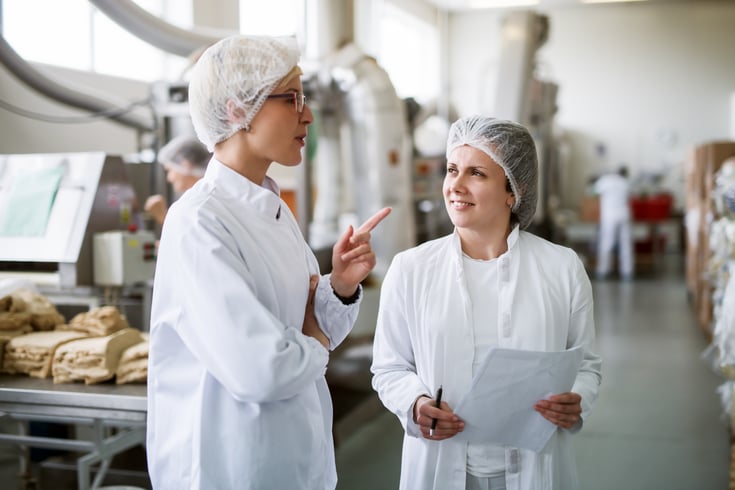October 15th is World Food Day. This has been an occasion acknowledged globally since 1945 to mark the founding of the United Nations Food and Agriculture Organization. The purpose of the day is mostly to take stock of world hunger and food insecurity throughout the globe. However, it can also be a good reminder of the importance of food safety.
Food safety is something that everyone should practice, including businesses. Obviously, companies that cook and prepare food need to be focused on food safety. However, any business that merely provides meals for employees also needs to understand the basics of food safety. In recognition of World Food Day, we wanted to share some important tips and ideas on how all businesses can promote food safety in the workplace.
Conduct Formal Safety Training
The best advice for any company in the food industry is to conduct formal food safety training with employees. This should go beyond teaching employees how to do their job properly. It should cover what they need to know about storing, preparing, and safely serving food. Even if what they learn doesn’t pertain specifically to their jobs, it should still be conveyed to them as part of food safety training.
It’s impossible to predict what food safety knowledge and practical learning will come in handy for someone. At times, employees may be asked to do something beyond the scope of their job. In these instances, formal food safety training will come in handy because they’ll know the right thing to do. In other words, as it pertains to food safety, every employee should be on the same level, which means sharing proper food safety practices with all employees no matter what their specific job entails.
Spell It Out
During food safety training, safety leaders need to be as specific and detailed as possible. It’s not going to be enough to instruct workers on the proper way to handle food safely in certain situations. Food companies must go one step beyond and explain why it’s important. Food safety knowledge will sink in much deeper if employees know the reason behind their actions.
This means spelling out the consequences of certain practices that are inherently risky and could lead to contamination or worse. If workers understand why they have to do things a certain way, they will be doing things with a purpose rather than blindly following instructions. Therefore, the more detailed safety instructions are with regard to why certain actions are required, the more you can rely on workers to follow safety protocols.
Assign Clear Responsibilities
Staying organized and holding people accountable are critical to creating a culture of food safety. This means giving employees clear roles and responsibilities that they must follow. There shouldn’t be any gray area when it comes to food safety. Everyone should know all of the ways they are responsible for maintaining proper food safety. Therefore, it will be easier to hold someone accountable if there is a mistake and correct that mistake as quickly as possible.
Ideally, there would be a certain amount of overlap when it comes to roles and responsibilities. In other words, multiple people are in charge of detecting issues and checking that everything is running smoothly as it relates to safety. The consequences – both for the business and for individuals – can be serious if there are shortcomings in food safety, so there is no such thing as being too careful or thorough.

Keep Hands Clean
Needless to say, this should be the first rule of food safety in the workplace. Employees need to understand the importance of keeping their hands clean whenever they handle food. A lack of proper hand washing is one of the most common causes of food-borne illnesses. Even if employees perform their work while wearing gloves, which is also a great way to promote food safety, they should still be washing their hands regularly.
If only wearing gloves and washing hands were that easy. Employers in the food industry need to be clear about the proper time for employees to wash their hands and the procedures they need to follow. The same applies to when they put on gloves and when they need to put on a fresh pair of gloves. Providing the right type of soap and setting for employees to wash their hands is also critical to ensuring employees who work with food follow proper hand-washing guidelines.
First In, First Out
Most food companies have no problem following this basic practice, but smaller organizations or in-house kitchens don’t always recognize its importance. The rule is simple: older items are always placed on top so they are the next to be used while new deliveries go on the bottom. This is to ensure that food doesn’t spoil and go to waste while also keeping supplies well organized. A disorganized kitchen is asking for trouble when it comes to food safety. Therefore, employees should be well schooled in the first-in, first-out methodology.
Keep Storage Areas Organized and Labels
Of course, practicing first in, first out is just one way that food storage areas stay organized. Another key part of the equation is making sure that everything is labeled. Every package or container of food in a fridge, freezer, or other storage area needs to be properly labeled. This doesn’t just mean labeling what’s in the package. It’s also important to label the date it arrived and the use-by date. This helps to ensure that food is always prepared before it goes bad.
It’s also important for companies to have a method to their madness when it comes to organizing various foods. Are foods organized by food group, alphabetically, or using some other method? Certain foods that are at risk of contaminating others should also be stored separately. Ultimately, it doesn’t matter how storage areas are organized as long as there is a system in place. This prevents items from being stored incorrectly or being forgotten about. Doing this will prevent mistakes that could potentially threaten food safety.
Monitor Temperatures
A huge part of food safety is cooking food at the right temperature. Equally important, those temperatures need to be monitored closely. This applies to both storage areas and while food is being prepared. Storage areas like walk-in coolers and freezers need to be monitored to ensure they remain in the proper temperature range. Likewise, the temperature of food that’s being prepared should be monitored so that it doesn’t move outside of a temperature range that’s considered safe.
Obviously, different foods have different temperature controls, which is what makes this so complicated. Managers and supervisors need to make sure that the temperature limits for individual foods are either known by every employee or can be easily referenced. Likewise, cooking thermometers need to be provided so that cooks know for sure if the food they’re preparing is in the proper range. If employees are left to guess whether temperature controls are being followed, there is no way to ensure proper food safety.
Follow Recipes
At home, many people like to experiment with their food rather than following exact recipes. Unfortunately, not following a recipe probably isn’t a good idea in a professional environment. This food is going to be consumed by a large group of people, so there are serious consequences if something goes wrong. Therefore, the recipe must be followed exactly every time for the sake of consistency.
Changing recipes on the fly doesn’t just alter the taste. It can also introduce new allergens or the possibility of cross-contamination. The bottom line is that the people consuming the food won’t eat what they think they’re eating. That can be dangerous, even if the food isn’t technically unsafe. Therefore, professional kitchens and food companies need to make sure they are following recipes they know to be safe every time.
Document Records
Keeping detailed records is important for safety in any environment, including food safety. Even if these are just internal records, there needs to be proof that proper safety protocols are being followed. These records can pertain to when products arrived, when they were prepared, how they were prepared, and when they were deemed ready to be served. The exact nature of a business will determine what needs to be documented, but there should be records nonetheless.
Keeping records is a big part of holding employees accountable for their food safety practices. If they need to write something down related to food safety, they will be forced to follow protocols. Likewise, if a mistake is made at some point, if there are records of everything, it should be easier to locate what went wrong and correct the issue.
Inspect and Audit
One final piece of advice for food safety is to conduct regular inspections and audits. This is another way to hold people accountable for food safety practices and stay ahead of potential problems. There is no need to wait until there is a problem or complaint because that means there was a food safety shortcoming. It’s better to be proactive and prevent any serious mishaps.
Part of the reason to perform internal inspections and audits is that it creates the opportunity to get better. With regard to safety in all workplaces, especially food safety, companies should always be looking for ways to improve. Performing inspections is a great proactive way to make improvements and prevent food safety from ever becoming a serious concern.

